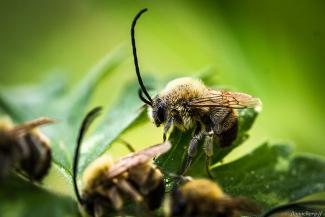
Image Credit: jean françois bonachera
Long-horned Bees (Anthophoridae: tribe Eucerini: Melissodes, Eucera (often called Tetralonia), Peponapis, Svastra)Peponapis (and the more southwesterly genus Xenoglossa) are specialists on the large-flowered nocturnal blooms of the pumpkin family. Svastra are generally found only on sunflower (Helianthus and related) flowers. The genera Agapanthinus, Martinapis, Florilegus, Simanthedon and Tetraloniella are all restricted to the southwestern deserts. Both Melissodes and Tetralonia (also known as Eucera) are abundant in the Pacific Northwest are contain many species. Northwestern Eucera fly during springtime and the females generally collect pollen from members of the pea family. Northwestern Melissodes are mostly all specialists during the late-summer to fall on members of the aster/sunflower family. The two genera are very hard to tell apart morphologically.



The males (left) have exceptionally long antennae; the females (center and right) have typical short antennae. The males are hard to mistake for any other groups, but identifying them to genus is extremely difficult, even for an expert. All of the species in all of the genera are excellent fast fliers. Pollen loads are usually very large (see center photo).


Most of the genera in this tribe are very non-diverse, containing only a single to a few species each. The 2 genera (Peponapis, Xenoglossa) specializing on the melon family (Cucurbitaceae) are never encountered without abundant host plants. Note that the scopal hairs of the female Peponapis (left) are rather sparse in order to receive the huge-sized pollen of squash. It is often said that Native Americans were well aware of the critical role these 2 genera played in the pollination of their crop plants (see “native bee-ology”) especially since few other flower-visiting insect goes to these night-blooming species.